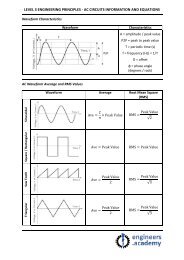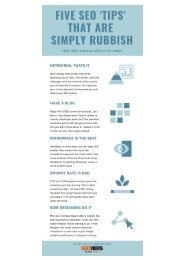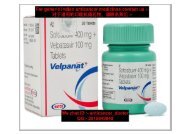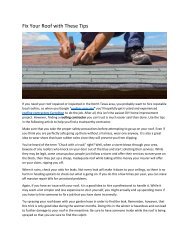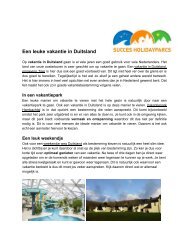The Ins and Outs of Prolotherapy
http://pegasuspain.com/ Although several medical interventions already exist for treating joint and back pain issues, one such treatment, Prolotherapy, is receiving more significant attention in the medical community.
http://pegasuspain.com/
Although several medical interventions already exist for treating joint and back pain issues, one such treatment, Prolotherapy, is receiving more significant attention in the medical community.
Create successful ePaper yourself
Turn your PDF publications into a flip-book with our unique Google optimized e-Paper software.
<strong>The</strong> <strong>Ins</strong> <strong>and</strong> <strong>Outs</strong> <strong>of</strong> <strong>Prolotherapy</strong><br />
Sufferers <strong>of</strong> joint <strong>and</strong> back pain <strong>of</strong>ten<br />
experience severe disruption to the<br />
quality <strong>of</strong> life <strong>and</strong> living. From missed<br />
work to restricted mobility, the impact <strong>of</strong><br />
back <strong>and</strong> joint pain negatively influences<br />
nearly every aspect <strong>of</strong> an individual’s life.<br />
Although several medical interventions<br />
already exist for treating joint <strong>and</strong> back<br />
pain issues, one such treatment,<br />
<strong>Prolotherapy</strong>, is receiving more significant<br />
attention in the medical community. We spoke with leading Dallas <strong>Prolotherapy</strong><br />
doctors <strong>and</strong> gathered this following info for you.<br />
<strong>Prolotherapy</strong> is a medical intervention that consists <strong>of</strong> injection a dextrose solution<br />
designed to stimulate healing. In other words, prolotherapy is a procedure where a<br />
natural irritant is injected into the s<strong>of</strong>t tissue <strong>of</strong> an injured joint. Essentially, the<br />
irritant kick-starts the body’s healing response in the affected area(s).<br />
Medical pr<strong>of</strong>essionals find prolotherapy most useful in the treatment <strong>of</strong> injured joints,<br />
ligaments as well as back pain. It is also considered an Alternative <strong>The</strong>rapy. <strong>The</strong><br />
following areas <strong>of</strong> the body are also considered appropriate c<strong>and</strong>idates for the<br />
procedure:<br />
• <strong>The</strong> knees.<br />
• <strong>The</strong> hips.<br />
• <strong>The</strong> shoulders.<br />
• Other joints <strong>and</strong> ligaments.<br />
History <strong>of</strong> <strong>Prolotherapy</strong><br />
<strong>The</strong> origins <strong>of</strong> prolotherapy weave back to the life <strong>and</strong> work <strong>of</strong> Dr. Earl Gedney, an<br />
osteopathic physician <strong>and</strong> surgeon. In 1930, Dr. Gedney suffered a major impact on<br />
his thumb, stretching the joint <strong>and</strong> causing acute pain <strong>and</strong> instability. His diagnosis<br />
was even grimmer, with medical pr<strong>of</strong>essionals at the time stating that his condition<br />
could not be helped. Dr. Gedney, however, chose to be his own physician <strong>and</strong> looked<br />
up a number <strong>of</strong> scholarly articles by herniologists. <strong>The</strong>se doctors used irritants to<br />
stimulate the repair <strong>of</strong> damaged tissues in a hernia. Dr. Gedney then adapted the
methodology to suit his needs <strong>and</strong> injected his injured thumb, eventually nursing it<br />
back to health.<br />
How does <strong>Prolotherapy</strong> work?<br />
<strong>Prolotherapy</strong> carries out its task by causing a temporary, low-grade inflammation at<br />
the injection site. This inflammation precipitates the activation <strong>of</strong> fibroblasts to the<br />
area, which, in turn, synthesize precursors to mature collagen <strong>and</strong> thus<br />
reinforce/repair connective tissues <strong>and</strong> ligaments. Research supports the theory that<br />
directly exposing fibroblasts to growth factors facilitates the growth <strong>of</strong> new cell<br />
tissues <strong>and</strong> the accumulation/deposition <strong>of</strong> collagen.<br />
In this case, the injured joint experiences an increase in ligament thickening, a<br />
broadening <strong>of</strong> the tendons <strong>and</strong> the strengthening <strong>of</strong> the damaged tendon or ligament.<br />
For increased efficacy, medical pr<strong>of</strong>essionals recommend administering several shots<br />
at the site <strong>of</strong> the injured joint or weakened area. Expected dosages may range from 4<br />
to 15 shots per session. In addition, the patient should expect several sessions to<br />
occur over the course <strong>of</strong> 3 to 6 months.<br />
Benefits <strong>of</strong> <strong>Prolotherapy</strong><br />
Supporters <strong>of</strong> the treatment look at the overall picture, which centers on not only<br />
healing but increasing the strength <strong>of</strong> the joint or area. This improved sturdiness<br />
augurs well for stability, movement, <strong>and</strong> function <strong>of</strong> the back <strong>and</strong> joints.<br />
<strong>Prolotherapy</strong> is also hailed as a natural treatment course that works in conjunction<br />
with the body to heal <strong>and</strong> repair itself.<br />
Potential Side Effects<br />
<strong>The</strong> most serious reported side effect <strong>of</strong> using <strong>Prolotherapy</strong> includes infection <strong>of</strong> the<br />
site after injecting the dose. <strong>The</strong> infection may cause a fever <strong>and</strong> pain <strong>and</strong> is<br />
treatable with antibiotics.<br />
Another side effect concerns the temporary swelling <strong>of</strong> the treated area. Usually, this<br />
swelling subsides as the joint repairs itself.<br />
Opponents <strong>of</strong> <strong>Prolotherapy</strong> frown at the use <strong>of</strong> sugar in the treatment. Doctors<br />
suggest that an accumulation <strong>of</strong> sugar in the affected areas could ultimately<br />
weaken/damage the joints. However, research is ongoing to determine the veracity <strong>of</strong><br />
this claim.
If you’re in the Dallas-Fort Worth area <strong>and</strong> would like to learn more about<br />
<strong>Prolotherapy</strong> or to schedule <strong>and</strong> appointment, connect with Pegasus Pain Management<br />
at PegasusPain.com today!



